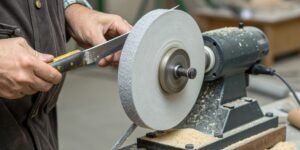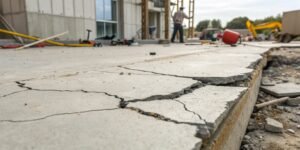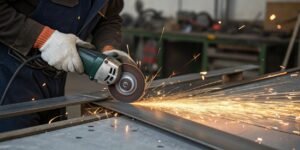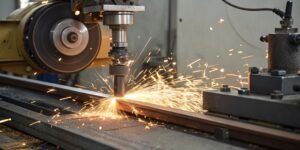
Can you use an angle grinder as a sander?
Have a project that needs sanding but only an angle grinder handy? One wrong move with the wrong tool can easily destroy your workpiece, wasting both time and material.
You can use an angle grinder for very rough sanding, like stripping paint or rust, with the correct attachment. But for fine, smooth finishing, you cannot. Its high speed and lack of precision will gouge or burn the surface. A dedicated sander is essential for quality work.

The short answer might surprise you because angle grinder1s are so versatile. I remember a new client from a large German manufacturing firm asking me about this very topic. They were looking to streamline their tool inventory and wanted to know if they could consolidate tasks. It’s a very common question we get at our factory, especially from businesses looking to maximize their investments. So, let’s break down the specifics and look at what works, what doesn’t, and why. We need to explore how these tools differ and what you really need for a perfect, professional finish.
Can angle grinders be used for sanding?
Sanding attachments and flap discs for angle grinders are sold everywhere. This makes you wonder why many experts advise against using them for sanding. Let’s clear up the confusion.
Yes, an angle grinder can be used for aggressive sanding tasks. This includes stripping old paint, removing rust, or shaping wood very quickly. However, it is not suitable for creating a smooth, fine finish. Its power and speed make it a tool for removal, not refinement.

An angle grinder’s main purpose is aggressive, high-speed material removal2. Its motor and gearing are designed to spin a disc at over 10,000 RPM. This is perfect for cutting metal or grinding down welds. When you apply this power to sanding, you get very rapid results, but you sacrifice all control.
When It Makes Sense
At our company, Reliable, we manufacture flap discs specifically for this purpose. They are built to withstand the immense force and heat. Using an angle grinder makes sense for tasks where the goal is to remove a lot of material quickly. This includes:
- Stripping thick layers of paint or epoxy.
- Removing heavy rust from steel beams.
- Grinding down and blending welds.
- Rough shaping of wood or metal.
When It’s a Bad Idea
It’s the wrong tool for any job that requires a delicate touch. A client once tried to finish a series of custom metal panels with an angle grinder. They ruined the entire batch with deep swirl marks that couldn’t be polished out. We had to help them source the correct finishing tools. Avoid using it for:
- Final sanding on a wood tabletop.
- Preparing a car body panel for painting.
- Sanding drywall.
- Any task where a smooth, flat, and visually appealing surface is the goal.
| Feature | Angle Grinder (with sanding attachment) | Dedicated Sander (e.g., Orbital) |
|---|---|---|
| Speed (RPM) | 10,000 – 12,000 | 2,000 – 10,000 (often variable) |
| Primary Motion | Rotational | Orbital / Random Orbital |
| Control | Low | High |
| Ideal For | Aggressive material removal | Fine finishing, surface preparation |
| Risk | Deep gouges, burn marks, swirl marks | Minimal risk of surface damage |
Can I turn my grinder into a sander?
You want one tool for many jobs to save money and workshop space. But forcing a tool into a role it wasn’t designed for can be inefficient and even dangerous.
You can attach accessories like flap discs or fiber disc backing pads to an angle grinder. This physically "turns" it into a sanding tool. However, it does not replicate the controlled, fine-finishing action of a dedicated sander. The grinder’s high-speed nature remains unchanged.

In my nearly three decades in the abrasives industry here in Henan, I’ve seen many attempts to create a "do-it-all" tool. As an OEM partner, clients often ask us to develop hybrid discs. But the physics of the tools themselves present limitations that no accessory can fully overcome. You can put sanding paper on an angle grinder, but it will never behave like a true sander.
Common Sanding Attachments
Several attachments allow an angle grinder to perform sanding-like tasks. We produce many of these under our RL brand, ensuring the abrasive grain and backing are tough enough for the job.
- Flap Discs: These are excellent for grinding and finishing in one step, especially on metal. They blend welds and deburr edges effectively.
- Fiber Discs on a Backing Pad: This combination is for heavy-duty jobs like removing rust or shaping metal. The stiff backing pad allows you to apply significant pressure.
- Wire Wheels: While used for cleaning and rust removal3 rather than sanding, they follow the same principle of aggressive, high-speed action.
The Functional Difference
The critical point is that these attachments don’t change the tool’s core function. An angle grinder is built to spin a disc on a single axis at very high speeds. It’s designed to dig in and remove material. A dedicated sander, particularly a random orbital sander, has a completely different mechanical action. It not only spins but also oscillates in a random pattern. This dual motion is what prevents deep scratches and swirls, creating a uniform, smooth surface. Simply attaching a sanding pad to a grinder doesn’t give you that essential oscillating action. It’s still a high-speed rotational tool at heart—a butcher knife trying to do the work of a surgeon’s scalpel.
Can an angle grinder be used as an orbital sander?
You need a perfectly smooth, swirl-free finish, the kind an orbital sander provides. You hope a special attachment for your grinder can do the trick, saving you another purchase.
No, an angle grinder absolutely cannot be used as an orbital sander. Their internal mechanics are completely different. An angle grinder’s head only rotates. An orbital sander’s pad both rotates and oscillates. No attachment can replicate this crucial dual-action on a grinder.

This question gets to the heart of the mechanical differences between the tools. It’s not just about speed; it’s about the very nature of the motion. Trying to make one perform like the other is fundamentally impossible and ignores the engineering that makes each tool effective for its specific purpose. For our high-precision manufacturing clients, understanding this difference is non-negotiable, as finish quality is directly tied to their reputation.
The Mechanics of Motion
Let’s break down the mechanics simply.
- Angle Grinder: Its gearbox is designed for one thing: to take the motor’s power and turn it into high-speed rotation at a 90-degree angle. The disc spins in a fixed, circular path.
- Random Orbital Sander: This tool has a much more complex mechanism. It uses an offset drive bearing and counterweight system. This makes the sanding pad spin while also moving around in a small, irregular elliptical pattern.
This random, oscillating movement is the key design feature. It cannot be added with a simple accessory. It must be built into the tool’s core.
Why It Matters for Your Finish
The motion directly impacts the finish.
- Angle Grinder’s Rotation: Because the abrasive grains travel in the same circular path over and over at high speed, they dig deep grooves into the surface. These are called swirl marks. They are very difficult and sometimes impossible to remove.
- Orbital Sander’s Random Motion: The random pattern ensures that no single abrasive grain follows the same path twice. This creates a much finer, more uniform scratch pattern across the surface. This non-directional finish is easy to smooth out with progressively finer grits and is ideal for paint, stain, or sealant application. Using an angle grinder for this is a recipe for a flawed, unprofessional finish.
What should you not use an angle grinder for?
The angle grinder is an incredibly useful and powerful tool in any workshop. But its power is also its biggest risk. Using it improperly can lead to serious injury or ruined materials.
Never use an angle grinder for tasks requiring fine precision, like finish sanding or intricate woodworking. Avoid using it without its safety guard, with damaged discs, or for cutting materials that produce hazardous dust without proper respiratory protection. It is a tool for force, not finesse.

As a manufacturer, safety is the most important part of our process. On our factory floor in Henan, we have strict protocols for testing our RL brand cutting and grinding discs because we know the forces involved. We pass this safety knowledge on to our clients. An angle grinder demands respect. Knowing its limits is crucial for both your safety and the quality of your work.
Top Applications to Avoid
- Fine Finishing: As we’ve covered, it will ruin any surface that needs to be perfectly smooth.
- Cutting Wood (with the wrong disc): Using a metal cut-off wheel on wood is extremely dangerous. The disc can easily bind in the wood fibers, causing a violent kickback directly at the operator. Special wood-cutting wheels for grinders exist, but they are for experts and still carry high risk.
- Plunge Cutting: Do not try to plunge the grinder into the middle of a material like you would with a circular saw. Grinders are designed for edge work. A plunge cut is unstable and a primary cause of kickback.
- Precision Cuts: An angle grinder is a freehand tool. Do not expect it to make perfectly straight, clean cuts suitable for joinery or tile work. Use a miter saw, tile saw, or track saw for that.
Essential Safety Rules
- Always Use the Guard: It’s there to protect you from shattered disc fragments and to deflect sparks.
- Always Wear PPE4: Safety glasses are mandatory. Gloves and a respirator are also essential, especially when grinding metal or masonry.
- Use Two Hands: A firm grip with both hands gives you maximum control.
- Inspect Your Discs: Before mounting any disc, check it for cracks or damage. Even our rigorously tested discs can be damaged in shipping.
- Match the RPM: Ensure the disc’s maximum RPM rating is higher than your grinder’s RPM.
Conclusion
In short, an angle grinder is for aggressive removal, not fine sanding. Always choose the right tool for the job to ensure quality results and, most importantly, your safety.
-
Explore the versatility of angle grinders and how they can be effectively utilized in various tasks. ↩
-
Explore the process of high-speed material removal and its benefits in machining. ↩
-
Explore effective methods for rust removal and the tools needed for the job. ↩
-
Find out the essential PPE required for safe operation of an angle grinder. ↩
Written by
leeon
You may also be interested in:

How to use a hard felt bench grinding wheel on knives?
Getting a razor-sharp, polished edge on a knife can be frustrating and slow. A dull knife is dangerous, and using the wrong tool can easily

What are grinding cracks and how do you stop them?
Are tiny cracks appearing on your ground surfaces? This problem leads to part failure, wasting time and money. You can solve it by understanding the

What does an angle grinder do that other tools can't?
Struggling with tools for multiple tasks? Carrying a heavy toolbox is inefficient. An angle grinder replaces many tools, saving you time and effort on the

How to reduce the cycle time in a grinding machine?
Is your grinding process a major bottleneck? Slow cycle times hurt your bottom line and delay deliveries. You can speed up production by optimizing key

Do you regularly sharpen your chisels? If so, how?
A dull chisel ruins wood and causes frustration. This wastes time and expensive materials. Learning to sharpen correctly is the simple, game-changing solution you need

Which material is used in making cutting wheel?
Have you ever used a cutting wheel that wore out too fast or just wouldn’t cut? The right material is key to solving this problem
